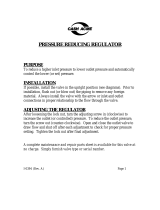
7
Lancer equipment (new or reconditioned) is shipped from the factory cleaned and sanitized in accordance with NSF
guidelines. The operator of the equipment must provide continuous maintenance as required by this manual and/or
state and local health department guidelines to ensure proper operation and sanitation requirements are maintained.
The cleaning procedures provided herein pertain to the Lancer equipment identied by this manual. If other equipment
is being cleaned, follow the guidelines established by the manufacturer for that equipment.
Cleaning should be accomplished only by trained personnel. Sanitary gloves are to be used during cleaning operations.
Applicable safety precautions must be observed. Instruction warnings on the product being used must be followed.
GENERAL INFORMATION
If a powder sanitizer is used, dissolve it thoroughly with hot water prior to adding to the syrup system. Ensure
sanitizing solution is removed from the dispenser as instructed. Avoid getting sanitizing solution on circuit boards. Do
not use strong bleaches or detergents; these can discolor and corrode various materials. Do not use metal scrapers,
sharp objects, steel wool, scouring pads, abrasives, or solvents on the dispenser. Do not use hot water above 140° f
(60° c). This can damage the dispenser.
! WARNING
• Use sanitary gloves when cleaning the unit and observe all applicable safety precautions.
• DO NOT use a water jet to clean or sanitize the unit.
• DO NOT disconnect water lines when cleaning and sanitizing syrup lines, to avoid contamination.
• DO NOT use strong bleaches or detergents; These can discolor and corrode various materials.
• DO NOT use metal scrapers, sharp objects, steel wool, scouring pads, abrasives, or solvents on the dispenser.
• DO NOT use hot water above 140° F (60° C). This can damage the dispenser.
• DO NOT spill sanitizing solution on any circuit boards. Insure all sanitizing solution is removed from the system.
! ATTENTION
CLEANING AND SANITIZING
Cleaning Solution
Mix a mild, non-abrasive detergent (e.g. Sodium Laureth
Sulfate, dish soap) with clean, potable water at a temperature
of 90°F to 110°F (32°C to 43°C). The mixture ratio is one ounce
of cleaner to two gallons of water. Prepare a minimum of ve
gallons of cleaning solution. Do not use abrasive cleaners or
solvents because they can cause permanent damage to the unit.
Ensure rinsing is thorough, using clean, potable water at a
temperature of 90°F to 110°F. Extended lengths of product lines
may require additional cleaning solution.
Sanitizing Solution
Prepare the sanitizing solution in accordance with the
manufacturer’s written recommendations and safety guidelines.
The type and concentration of sanitizing agent recommended in
the instructions by the manufacturer shall comply with 40 CFR
§180.940. The solution must provide 100 parts per million (PPM)
chlorine (e.g. Sodium Hypochlorite or bleach) and a minimum of
ve gallons of sanitizing solution should be prepared.
Following sanitation, rinse with end-use product until
there is no aftertaste. Do not use a fresh water rinse.
This is a NSF requirement. Residual sanitizing solution
left in the system creates a health hazard.
! CAUTION
Cleaning and Sanitizing Nozzles
1. Disconnect power, so as to not activate valve while cleaning.
2. Remove merchandiser to reveal valves.
3. Remove nozzle by twisting counter clockwise and pulling
down.
4. Remove diuser by pulling down.
5. Rinse nozzle and diuser with warm water.
6. Wash nozzle and diuser with cleaning solution then
immerse in sanitizing solution and let sit for fteen (15)
minutes.
7. Set nozzle and diuser aside and let air dry. DO NOT rinse
with water after sanitizing.
8. Reconnect diuser and nozzle.
9. Connect power.
10. Taste the drink to verify that there is no o-taste. If o-taste
is found, ush syrup system again.
A
B
C
A. Nozzle
B. Diuser
C. Soda Lever












